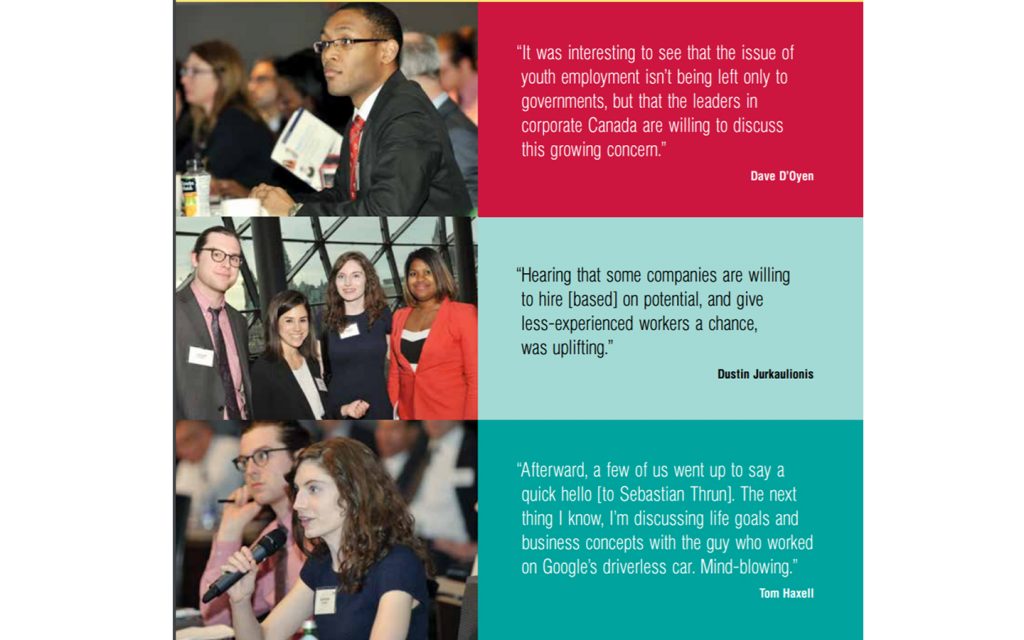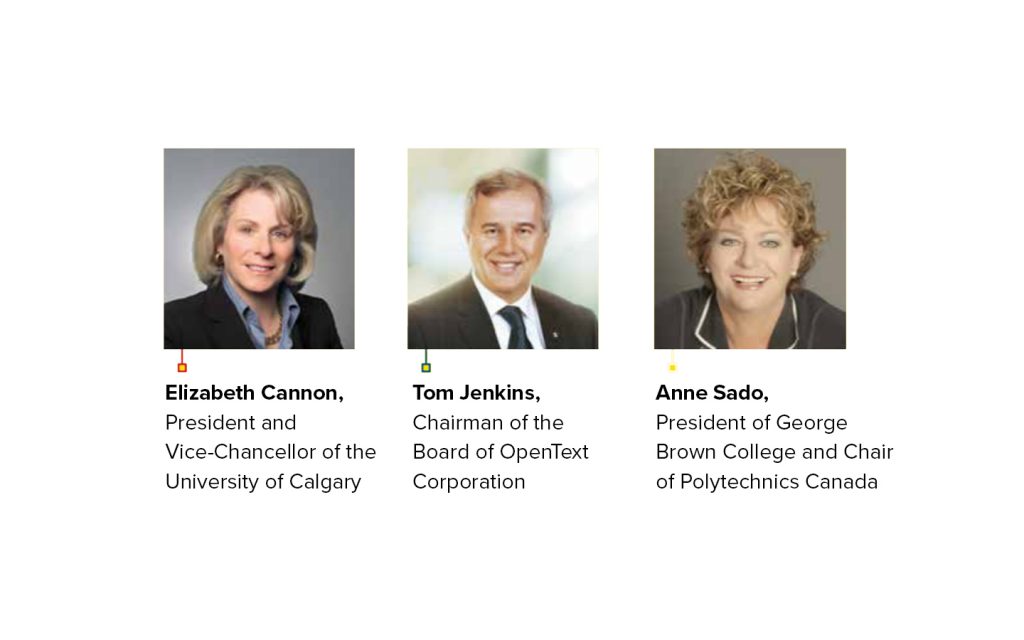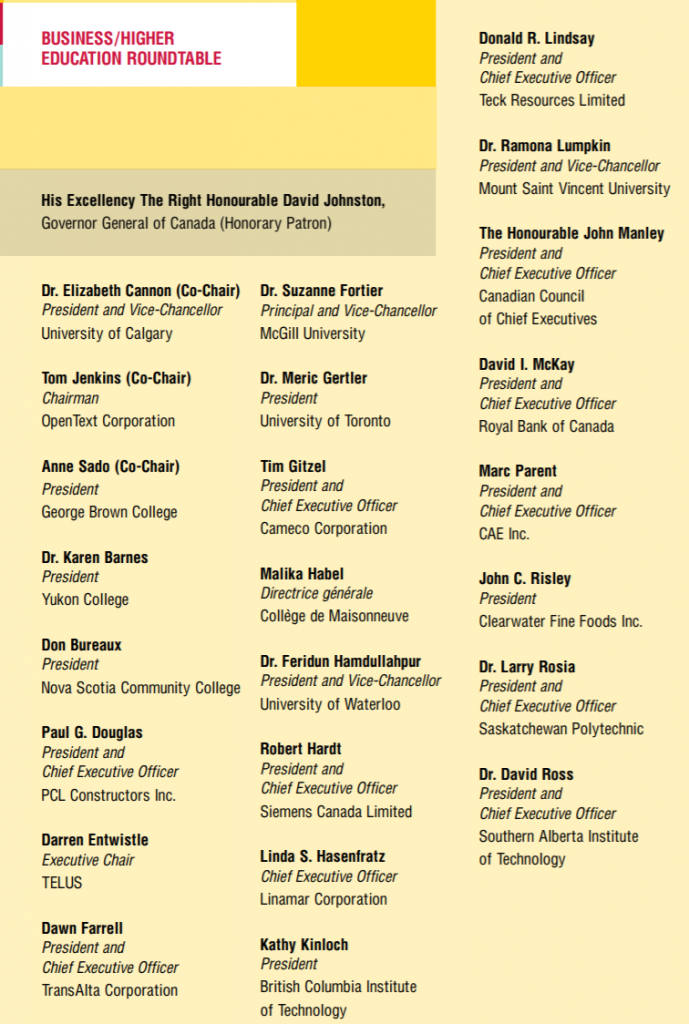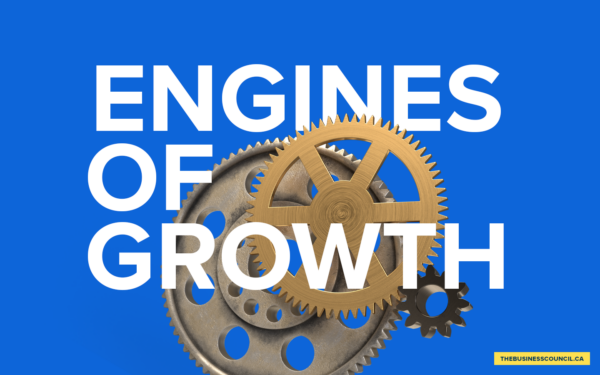Annual Report 2014/2015
Creating Opportunities
ABOUT THE CCCE
The Canadian Council of Chief Executives (CCCE) is a not-forprofit, non-partisan organization composed of the CEOs of Canada’s leading enterprises. The CCCE engages in an active program of research, consultation and advocacy on issues of national importance to the economic and social fabric of Canada. Member CEOs and entrepreneurs represent all sectors of the Canadian economy. The companies they lead collectively:

and are responsible for the vast majority of Canada’s exports, business
investment, private-sector research and development, and employer-sponsored education and training.

Message from the Chair

As an organization representing most of the country’s leading employers, the Canadian Council of Chief Executives has a vital and direct stake in the quality of Canada’s labour market. Year after year, the Council’s 150 member companies are among Canada’s largest recruiters of young people. Our firms provide mentoring, on-the-job training and development opportunities that assist young men and women in achieving their career aspirations.
By creating opportunities for young Canadians, we are helping to build our companies’—and our country’s—future. As employers, we recognize that many students and recent graduates are worried about the state of the job market. The youth unemployment rate has declined over the past several years, but remains far too high. Many young people find the transition from school to work difficult, and feel trapped in a cycle of low-wage, uncertain employment.
Two years ago, our Council launched an initiative aimed at improving the outlook for the next generation of Canadian workers. Our goal was to bring business, educators and government together to ensure that Canadians have the education and training they need to succeed in the 21st century.
We consulted widely, drawing on the expertise of educators and policy innovators across the country. Out of those discussions emerged a series of reports dealing with subjects as varied as: the quality of teaching in primary and secondary schools; the need for expanded apprenticeship training opportunities; the role of governments in framing a national education and skills strategy; the impact of new technology on post-secondary education; Canada’s international education strategy; and how large firms can help nurture the next generation of young entrepreneurs.
“Accelerating technological innovation underscores the importance of lifelong learning, to ensure that workers keep pace with changing skill
requirements. Our Council intends to play a constructive role on this front by fostering a national conversation on the value of employer-sponsored learning and development. “
There are no easy answers to Canada’s labour market and skills challenges. Youth unemployment and under-employment are to some extent symptoms of deeper issues, involving a complex interplay of economic, demographic and social factors. None of these problems can be dealt with in isolation, and opinions differ on the best way to address them. Still, our research did highlight some critical lessons for Canadian policymakers, and for ourselves as major employers.
First, students need accurate, timely labour market information—including data on wages and salaries, qualifications and industry trends—on which to base their educational and career choices. That, in turn, implies that employers across the economy need to do a better job of communicating their anticipated skill needs.
Second, the countries that are most successful in moving young people from school to work tend to be those where there is a tradition of close collaboration between education providers and employers. In Canada, the academic and business communities have at times behaved as though they were in separate silos— something we hope to remedy with the launch of the Business/Higher Education Roundtable, co-founded by Tom Jenkins, Chairman of OpenText Corporation.
Third, accelerating technological innovation underscores the importance of lifelong learning, to ensure that workers keep pace with changing skill requirements. Our Council intends to play a constructive role on this front by fostering a national conversation on the value of employer-sponsored learning and development. I am grateful to Elyse Allan, President and Chief Executive Officer of GE Canada, for offering to spearhead the initiative. On behalf of Canada’s business leaders, thank you for your interest in our policy agenda. We look forward to working with partners and stakeholders in all areas of society in our mission to help build a stronger, more resilient Canada.
Paul Desmarais, Jr.
Chair

Message from the President and CEO

As this Annual Report went to press, the 2015 federal election campaign was in full swing. All of the major parties had put forward detailed election platforms, filled with promises on a long list of issues.
The Canadian Council of Chief Executives is a nonpartisan organization, so it’s not our practice to comment on the specifics of each party’s agenda. But our own agenda is easy to summarize. It’s an attempt to answer a simple but fundamental question: How can we strengthen Canada’s ability to compete and grow in the global economy?
“Canada’s next government should work to secure Canada’s place in the Trans-Pacific Partnership, a game-changing agreement that would deepen our commercial engagement in the dynamic and fastgrowing Asia Pacific region.”
We live at a time of accelerating change and economic disruption. To stay ahead, we need to avoid the short-term myopia that hampers our ability to address longterm policy challenges. We need to think seriously about the kind of Canada we want—not just today or tomorrow, but a generation or more down the road. Here are three essential elements of a long-term strategy for success:
Embrace open markets. Millions of jobs across Canada—a third of our GDP— depend on our country’s ability to sell to customers in other countries. By dismantling trade barriers, we create new opportunities for exporters. And that’s not all. In the words of the OECD, “The results of trade openness can be tangibly measured in terms of economic growth, productivity, a higher standard of living, further innovation, stronger institutions and infrastructure, and even promotion of peace.” In pursuit of those objectives, Canada’s next government should move quickly to ensure the ratification of the Canada-EU Comprehensive Economic and Trade Agreement. It should work equally hard to secure Canada’s place in the Trans-Pacific Partnership, a gamechanging agreement that would deepen our commercial engagement in the dynamic and fast-growing Asia Pacific region.
Commit to a competitive tax system. Rather than focusing only on statutory corporate income tax rates, we need to stand back and consider the big picture. This year’s PwC Total Tax Contribution Study should be on the reading list of every elected official in the country. Based on a survey of 80 leading companies, it found that large firms pay at least 56 different kinds of taxes to the three levels of government. The public sector is the largest beneficiary of value distributed by large business: For every $100 firms pay out, $40 goes to government, compared to $28 for employees and $32 for shareholders, most of which is reinvested in the business. Critics claim large companies don’t pay their share, but the numbers prove otherwise: corporate tax revenue today is fully in line with the historic average. Yes, Canada’s tax system needs reform, but the goal should be to reduce tax complexity and broaden the base—measures that will attract investment and create jobs.
Recognize the importance of scale. The implementation of the Canada-U.S. Free Trade Agreement, followed by NAFTA, exposed Canadian companies to the discipline of competition on a continental—not just national—basis. Today, the biggest opportunities lie farther afield, in emerging markets and supply chains that stretch around the world. Companies need scale to compete at that level, yet public policy in Canada often works against them. The tax code actually penalizes firms for growing, and politicians frequently resort to “big is bad” rhetoric to appease consumers. In reality, the best way to keep companies on their toes is to open the door to more competition. Rather than taking swipes at successful Canadian companies that have a track record of investing and creating high-value jobs, government’s job should be to create the conditions under which smaller firms can grow and become significant exporters.
Few if any countries are blessed with Canada’s natural advantages and long history of sound governance. But we cannot afford to take our future prosperity for granted. We need smart public policy, focused business leadership and a clear vision to achieve success in the 21st century global economy.
The Honourable John Manley, P.C., O.C.
President and Chief Executive Officer

Year in Review
Economic and fiscal policy
After five consecutive years of deficits during which Canada’s federal debt ballooned by more than $150 billion, the Government of Canada forecast a narrow surplus for the fiscal year ending March 31, 2016. The Canadian Council of Chief Executives welcomed the anticipated return to balanced budgets, adding that the time has come for policymakers to shift their focus toward measures that will promote faster economic growth and a rising standard of living. “Balanced budgets give governments the ability to respond in the event of unexpected shocks,” said The Honourable John Manley, the Council’s President and Chief Executive Officer. “But eliminating red ink is not enough to ensure Canada’s longterm prosperity. The next step is to implement a comprehensive strategy for economic growth, increased business investment and job creation.”

On the fiscal front, the Council remains concerned about high levels of public debt and structural shortfalls at the provincial level—particularly in Quebec, Ontario and the Atlantic provinces. Indeed, as a share of Canada’s GDP, the net debt of all provinces and territories is now almost as great as the federal debt. Moreover, demographic pressures in several of the most indebted provinces are sure to magnify the fiscal burden, with a shrinking ratio of younger workers to cover the costs of a rising cohort of older citizens.
Federal Net Debt vs. Provincial Net Debt

Trade and investment
The past year was a promising one for Canadian export initiatives. After a six-year period of under-performance, two-way trade with the United States finally returned to pre-recession levels. Heading into 2016, a strengthening U.S. recovery appears likely to buoy Canada’s own economic performance—while at the same time underscoring the need to modernize Canada-U.S. border infrastructure.
While maintaining our country’s historic trade relationship with the United States is essential, the emergence of new markets around the world represents a critical opportunity for Canadian companies and workers. The Trans-Pacific Partnership (TPP), a proposed trade agreement among 12 Pacific Rim countries, is a key priority for Canadian business. As the Council noted in a letter to Prime Minister Stephen Harper in early 2015, a successful outcome to the TPP negotiations would give Canadian exporters improved access to 800 million consumers representing 40 per cent of the world’s GDP. Together with the Canada-EU Comprehensive Economic and Trade Agreement—which has yet to be ratified— the TPP would significantly expand Canada’s global trade footprint.

Canada made a number of other important strides in its commercial relations with Asia in 2015, including:
- In January, the federal government signed a free trade agreement with South Korea—our first with any Asian country.
- In February, Canada and China announced a reciprocal agreement on long-term and multiple-entry visas for business travel, tourism and family visits. Valid for up to 10 years, the new visas should significantly increase bilateral travel and trade, helping Canadian firms make inroads into the Chinese market.
New rules on state-owned enterprises have added time and uncertainty to the foreign investment screening process, damaging Canada’s reputation as a champion of open markets
Innovation and competitiveness
Over the years, the Council has sought to make Canada a more attractive destination for investment, talent and innovation. We have also supported policies aimed at increasing the level of competition within Canada, believing that such measures help to build stronger companies that can compete on the global stage.
The 2008 report of the federal Competition Policy Review Panel, led by L.R. (Red) Wilson, put forward a series of important proposals in both of these areas, only some of which have been put into effect. In late 2014, the Council asked Paul Boothe, Director of the Lawrence National Centre for Policy and Management at Western University’s Ivey Business School, to conduct an assessment of the government’s progress in implementing the Wilson Panel’s recommendations. Boothe’s report, published in March 2015, gave credit to the government for its business-supportive tax policies, reforms to immigration and intellectual property rules, and efforts to facilitate and expand international trade.
It is time for Canada, the United States and Mexico to come together in a fresh drive to modernize North American commerce.
At the same time, Boothe identified a number of areas where significant work remains—and a few where the policy environment has become worse. Examples:
- In the critical area of foreign investment review, not only did the government fail to implement positive reforms—such as raising the threshold for review of most foreign acquisitions to $1 billion—but the review process itself has become less certain and more opaque.
- New rules on state-owned enterprises in particular have added time and uncertainty to the foreign investment screening process, undermining Canada’s attractiveness as a destination for investments that create jobs and benefit consumers.
- Canada’s personal income tax system has become more complex as a result of what Boothe terms a “plethora of personal tax measures that fragment and complicate the tax system”.
- The government has yet to take meaningful steps to enhance competition in telecommunications and air transportation. Boothe says it could do so by loosening foreign ownership restrictions and allowing foreign firms to enter the Canadian market on an equal footing with domestic players.
North America
The North American Free Trade Agreement (NAFTA), which took effect in 1994, marked a significant improvement in Canada’s commercial relationships with the United States and Mexico. But after 21 years, the continental trade and investment framework is showing its age. Case in point: NAFTA pre-dates the widespread adoption of many of the core technologies that guide the cross-border movement of goods, services and people—from online shopping and mobile commerce to ubiquitous, real-time satellite tracking systems.
The Council believes it is time for Canada, the United States and Mexico to come together in a fresh drive to modernize North American commerce. In a report called “Made in North America,” we developed a 44-point agenda to strengthen the region’s competitiveness and address gaps in supply chain and border management. Among other steps, the report calls on the public and private sectors to harness the powers of technology and so-called “big data” to streamline the movement of cargo while strengthening border security. “The ‘security trumps trade’ argument is a false dichotomy,” the report says. “Through the practical application of big data, we can ensure that security and trade facilitation are mutually reinforcing rather than mutually exclusive.”
Other recommendations include:
- Embracing new financing options—such as public-private partnerships—to support major investments in border infrastructure;
- Developing and promoting a “Made in North America” brand;
- Expediting the cross-border movement of workers for training and skills development;
- Updating NAFTA’s list of professionals eligible for temporary entry; and
- Enhancing North American cooperation on cyber-security.
Alongside these efforts, the Council has continued to encourage the Canadian and U.S. governments to pursue improvements in border management and infrastructure under the 2011 Beyond the Border Action Plan. In March 2015 we welcomed the signing of a new Canada-U.S. customs
preclearance agreement. “For many years, travellers passing through major airports across Canada have benefitted from the ability to clear U.S. customs before leaving Canada for their destination,” Mr. Manley said. “Today’s agreement ensures not only that these customs preclearance facilities will be funded for years to come, but also that additional preclearance facilities will be opened for air, rail and marine passengers.”
Corporate governance
As an association of business leaders, the Council is commited to high standards of corporate governance and ethical conduct. As well as enhancing Canada’s reputation as a place to invest and conduct business, good corporate governance, accountability and transparency are essential in ensuring that firms gain the approval and support of local communities and other stakeholders for their business activities.
The federal government has for many years supported sound business practices through its commitment to purchase from suppliers that respect the law and act with integrity. As well as enhancing Canada’s reputation as a place to invest, good corporate governance, accountability and transparency are essential in ensuring that firms gain the support of local communities

In 2014, however, Public Works and Government Services Canada introduced revisions to its anti-corruption regime that violated basic standards of procedural fairness and far exceeded the rules that apply in other leading economies. Under the revised rules, companies bidding on federal contracts would have to certify that neither they nor their affiliates—including firms with little or no connection to the Canadian operation—had been charged during the past 10 years with any of a long list of criminal offences, anywhere in the world. Concerned that the new regime could deter investment in Canada and be challenged by foreign partners as a restraint on trade, the Council urged the government to reconsider its approach. We subsequently welcomed the introduction in July 2015 of a new procurement integrity framework that will promote ethical business practices while ensuring due process.
The Council also welcomed the government’s announcement that it supports a “comply or explain” approach to increasing the number of women on corporate boards. The complyor-explain model increases transparency in the board selection processes while providing companies with flexibility to adapt their corporate governance practices to their specific circumstances, including firm size, ownership structure and industry characteristics.
Energy and the environment
Canada’s diverse energy resources are a source of comparative advantage for the country and a major contributor to economic prosperity, government revenues and job creation. The Council believes governments at all levels should participate in the development of a shared energy and resource vision— one that encourages the responsible development of Canada’s energy assets, both fossil-based and renewable. Equally important is the need for modern, safe and resilient infrastructure to deliver energy across the country and to international markets.
The energy potential across North America is profound. Improved cooperation among Canada, the United States and Mexico can position North American producers to supply competitively priced energy efficiently and with less environmental impact.
Canada’s oil and gas industry supports more than 550,000 jobs for professionals and skilled trades—and generates one-fifth of the country’s exports
The Council supports the use of carbon pricing as a means of encouraging consumers and businesses to invest in innovative technologies, use energy wisely and reduce emissions of greenhouse gases (GHGs). Several provinces have introduced carbon-pricing schemes, and others appear likely to join them. In the absence of a consistent national approach to carbon-pricing, the Council urges provinces to minimize the number of conflicting obligations for firms that operate in different jurisdictions and ensure that such requirements do not put Canadian firms at a significant disadvantage to their international competitors. In addition, carbon-pricing plans should be revenue-neutral, with the costs offset by reductions in other taxes, both corporate and personal.
In advance of United Nations climate change negotiations in Paris in December 2015, the federal government set a target to reduce GHG emissions by 30 per cent relative to 2005 levels by 2030. Meeting this objective will require sustained public engagement, smart public policy and much closer cooperation among the federal, provincial and territorial governments. Canada’s success in addressing the climate change challenge will also depend on policies that enable firms to invest in new technologies that improve business competitiveness as well as environmental performance.

Creating Opportunities
When young Canadians finish school and enter the full-time workforce, they face many of the same hurdles that previous generations encountered. But in at least one respect, the labour market has changed dramatically over the past 20 years. Previously, Canada was among a handful of well-off countries able to provide their citizens with a highquality public education, from kindergarten through high school, college or university. Today, rapid economic growth in Asia, Latin America and elsewhere means that the number of well-educated, ambitious young people around the world—the emerging global talent pool—is much larger.
To thrive in this new, more competitive, knowledge-based environment, Canada must ensure that its education and training systems are among the world’s best. The Canadian Council of Chief Executives recognizes that the private sector has an important role to play in helping Canada overcome these education and skills challenges. In 2013, we launched a multi-year research and advocacy initiative called Taking Action for Canada: Jobs and Skills for the 21st Century. We surveyed our members’ skill requirements and hiring intentions, commissioned a series of discussion papers and in-depth reports, and consulted with a wide range of experts and organizations in government, policy research institutions and the education sector.
“You can’t change the world without a certain amount of healthy willingness to break the rules.”
Sebastian Thrun, Udacity
We also commissioned a survey of 18-to35-year-olds to learn more about their attitudes toward the job market and their futures. Far from revealing a generation in crisis, facing a doubtful and discouraging future, the survey found that young Canadian adults are significantly more likely to say they are optimistic rather than pessimistic about their career prospects. In fact, 46 per cent of those surveyed expect that their generation will enjoy a higher standard of living than their parents, while 30 per cent think it will be the same. “Most young Canadians don’t see themselves as ‘Generation Jobless’,” said David Coletto of Abacus Data, the lead researcher on the study. “They have established themselves in—or are working toward—a career they like and are achieving the goals they set for themselves.”
In April 2015, the CCCE assembled all of this thinking for a conference titled “Creating Opportunities: Jobs and Skills for the 21st Century”. Business leaders, educators, government officials and young people discussed the outlook for Canada’s millennial generation, how to better align education with the skills employers need, and what business leaders can do to improve their own workplace learning and development programs. The conference included keynote presentations by Mona Mourshed, global education lead for McKinsey & Company, and Sebastian Thrun, the renowned technology pioneer who launched Google’s self-driving car project and now runs Udacity, an online university that teaches sought-after skills at a fraction of the cost of traditional schools.

The conference also featured a special appearance by His Excellency The Right Honourable David Johnston. Prior to his appointment in 2010 as Canada’s 28th Governor General, Mr. Johnston had a long and distinguished academic career, including serving as dean of law at the University of Western Ontario, principal and vice-chancellor of McGill University, and president of the University of Waterloo.
Our focus on labour market issues continues. On the eve of the conference, we announced the creation of the Business/Higher Education Roundtable, an initiative that brings together leaders from the private sector and Canada’s post-secondary system to share ideas, expand collaborative research activities and help students acquire the knowledge and skills they need to find secure and rewarding careers. Reflecting his extensive experience in higher education, his concern for youth and his belief in the value of research and innovation, the Governor General has agreed to serve as Honorary Patron of the Roundtable.
“The growth of co-op programs is one of the most important developments in postsecondary education. If I was starting a university right now, every program would include practical work experience.”
His Excellency The Right Honourable David Johnston,
Governor General of Canada
Another outcome of the Council’s work on jobs and skills was the launch of a national business-led effort to raise awareness of the importance of workplace learning and development. “Canadian employers as a group can and should do more to ensure that Canadians have the education and skills needed to find and keep good jobs now and in the future,” said Elyse Allan, President and CEO of GE Canada, who is spearheading the initiative. As part of the project, the Council will develop common approaches to measuring employer investments in education and training, conduct regular surveys to enhance understanding of workplace training activities, and develop a network of human resource professionals to share best practices and exchange ideas on how to improve employer-sponsored training in Canada.

In early 2015, the Council sponsored a competition in which young Canadians were invited to share their thoughts on youth employment. Seven students and recent graduates won trips to Ottawa to attend the “Creating Opportunities” conference.


Learning and Working Together
Business/Higher Education Roundtable
How can Canada help its young people move successfully from education to employment? One obvious step is to encourage closer collaboration between employers and our country’s institutions of higher education. In Spring 2015, the Council announced the launch of the new Business/Higher Education Roundtable, a national body composed of 27 leaders from the private sector and Canada’s post-secondary institutions. One of the goals of the Roundtable is to help more Canadian graduates secure good jobs and a bright future. It will also work toward improving life-long learning and strengthening research partnerships between companies and educational institutions.
The Roundtable’s three co-chairs are:

The CCCE’s Isabelle Duchaine spoke with each of the co-chairs about the initiative.

Jenkins: One of the great conundrums in Canada’s economy is that we’re teaching skills that don’t match up to the demand. This is incredibly inefficient. It’s also unfair to the young people who have worked hard to develop specific skill sets, only to find that they cannot apply those skills in the area or sector they were focused on.
Sado: I’d add that post-secondary institutions are critical drivers of the economy. By linking the world of learning and the world of work, we can better prepare Canadian talent to meet rapidly changing market needs.
Cannon: Traditionally, we’ve thought of colleges and universities as separate from the business world. But the reality is that educational institutions can’t do everything on their own and partnerships are essential. In a knowledge-intensive society, we must use all of the tools and linkages at our disposal to educate young people – and that includes working with business.

Sado: A lot of this has to do with the diversity of Canada’s post-secondary landscape. For one thing, education remains under provincial jurisdiction. There’s also tremendous diversity among universities, between colleges, and among polytechnics. In the past, coordination at the national level wasn’t as critical, but the transformation of Canada’s industrial sector—and increasing competition from the global marketplace—means that we need to change. If we don’t coordinate nationally, countries with national education strategies will outpace us.
Cannon: Over the past 10 years there’s been a growing recognition that the education and business communities must work together. Kudos to the Council for stepping up to the plate and launching this initiative, bringing together a key group of thought leaders passionate about the future of our country.

Cannon: First, we need to identify the issues and analyze best practices – both in Canada and internationally. Then we need to propose concrete actions. With the right people around the table, there’s no reason why we can’t implement solutions that have long term, measurable impact.
Sado: In the short term, I’m looking for a stronger understanding of how our sectors can support one another. There’s not a one-size-fits-all solution to many of these issues. We need to develop solutions that work across different sectors, geographies, and types of industry.
Jenkins: One of my priorities is to see that existing labour-market data is made more easily accessible, especially for youth. In the long term, we need to standardize how this information is presented and make it understandable.

Jenkins: I’m struck by the fact that a high percentage of college students have already earned a university degree. Beyond the inefficiency and the cost to taxpayers, it’s demoralizing for students. It’s hard enough to get one credential, never mind revisiting your education to develop new skills in a different field. We need to do a better job of explaining what students can expect if they pursue a particular program or field of study. In some cases that might mean encouraging young people to consider college first rather than university. Or it could mean highlighting the skills bundled within a university degree program.
Sado: On the point about returning to school, I’d caution that generalities are dangerous. Maybe with more information, some students wouldn’t choose to attend university before enrolling in a college program. But often students who have a passion for a subject or a career area can garner a great breadth of knowledge by pursuing a degree, and yet still face difficulty landing a specific job. There’s nothing wrong with connecting the knowledge gained through a university degree with the know-how acquired through an applied program at a college or polytechnic. Generalists may need to acquire specialist skills: this combination equips new workers with the range of skills employers are looking for.
Cannon: I am convinced we can create better mechanisms to help youth transition from our post-secondary institutions to society. And that means finding better ways to dovetail experiential learning with classroom learning, and smoother pathways between different types of educational institutions. The Roundtable is a chance to get the entire system to work together and catalyze novel solutions.
“We need to do a better job of explaining what students can expect if they pursue a particular program or field of study. In some cases that might mean encouraging young people to consider college first rather than university. Or it could mean highlighting the skills bundled within a university degree program.”
Tom Jenkins

Jenkins: My view is that these two solitudes cannot exist in isolation. Our society functions successfully when all of the different components work together. We’re tackling the same questions: How can we create a sustainable society? How can we support future generations of young Canadians, so they can contribute to their communities? How do we build capacity to further our quality of life?
Cannon: I believe that educators and business leaders are equally concerned about the future of our country and its economic and social well-being. This is the starting point for dialogue followed by action. By ensuring that our youth have opportunities to develop intellectually and personally, followed by tangible pathways for employment, we will ensure the long term prosperity of Canada.

Sado: Colleges and polytechnics have been working with employers for many years, but the relationships are deepening now. It’s a two-way street. We have employers actively counseling us through program advisory committees, and meanwhile employers are increasingly seeking our expertise in applied research.
Cannon: More so than in the past, we’re recognizing that universities can’t teach every skill set. For example, partnering with business makes a lot of sense if the objective is to teach entrepreneurial skills. The converse is also true: a business environment isn’t the most conducive place for detailed exposure and training in analytical or critical thinking skills – the kinds of things a university degree is all about. Partnerships bring everyone’s strengths to the table and it’s time for us to leverage these to greater impact.
Jenkins: Over the past few decades, we’ve seen incredible collaboration on the research agenda. Universities and more recently colleges have rapidly expanded their research capacity, in partnership with government and business. This collaboration delivers tremendous benefits to Canadians, because it kick-starts and supports the transition of innovation from the research level into our daily lives. The Roundtable will encourage and expand this kind of collaboration.
I strongly endorse co-ops, but don’t forget that there are many other kinds of work-integrated learning.
Anne Sado

Sado: It’s a joint responsibility. Both sides of the education and employment continuum must be responsive to demands for talent and skills. The government also holds some responsibility in ensuring mobility as students move across the country in pursuit of jobs.
Jenkins: Yes, we all carry that burden: businesses, institutions, governments and individual students. At our end, we’re stepping up to make information readily available and understandable.

Cannon: While it can be helpful to talk with recent grads, I’d caution against focusing too heavily on this. The job market is evolving and many future career opportunities don’t even exist now. The job of a university is to give students a broad-based education that is applicable and transferable across domains so that students are prepared for whatever job market faces them.
Jenkins: A student’s peer group is an excellent source of relevant information about the current job environment. To me it just makes sense for students to sit down and discuss the transition from school to work with someone who has recently been in their shoes.
Sado: Hearing about other graduates’ employment experiences is helpful, but I’d also encourage new grads to pay attention to [labour market] projections over the next five or 10 years. Just think about the range of opportunities that weren’t available as recently as five years ago, such as 3D printing. Picking a field of study is about looking forward as well as looking back.

Jenkins: As an employer, I absolutely endorse this. Co-ops offer tremendous benefits to companies as well as students. Students get to test-drive a particular career, and companies get the chance to work with potential new employees.
Sado: I strongly endorse co-ops, but don’t forget that there are also many other kinds of work-integrated learning opportunities. That includes applied research projects, apprenticeships, health-sector clinical placements and practicums.
Cannon: Co-op programs are enormously helpful when done right and I believe there is much more to do in this direction. Expanding these programs will benefit both the students and employers and often bring direct value back into the classroom since students will bring their experiences into their academic learning.

Sado: First, I hope that governments will continue to invest in post-secondary institutions. Another key element would be to improve national coordination. We can learn a lot from jurisdictions that have overcome similar challenges.
Jenkins: I’d like to see us tighten the feedback loop between the skills our country needs to compete on a global level, and what’s actually happening within our education system. The first step is to compile accurate information about the jobs and skills that are in demand on a national level. Then we can identify the gaps and start to address them.
Cannon: We live in an increasingly knowledge-intensive society where post-secondary education is a central component. To tackle the significant challenges facing society, we need to make sure our post-secondary system is outward facing, based on excellence and ready to partner with the external world.

Jenkins: There’s a quote from Wayne Gretzky that goes something like, “Don’t skate to where the puck is—anticipate where it’s going to be.” As employers, we have a huge amount of information about the future direction of our enterprises. Our long-term planning includes details on new markets, global value chains and the kinds of new talent we are going to require. Part of the responsibility of the private sector is to communicate these trends, to help students assess where the puck is going.

Cannon: I don’t think young people should be trying to choose between learning a narrow skill or studying something broad. Rather, choose an area in which you are passionate and then take advantage of the opportunities your institution offers both in the classroom and outside, whether co-op programs, international exchanges, or work-learn options. When you graduate, it’s ok if you don’t get your “dream” job right-away. All the evidence shows that within a couple of years of graduating, unemployment rates for graduates from our post-secondary system are low. The key is to get yourself into the labour force and you’ll find ways to link your broadbased education to specific skills.
Sado: I tell students—and my own kids—to do their homework. You need to do research, but also follow your instincts. There’s a lot of anxiety surrounding career prospects, but it’s important to remember that the transition from school to a workplace isn’t linear. In fact, students will find that careers aren’t always linear, either.
Jenkins: My message is, “As a young Canadian, you have an amazing future ahead of yourself. Your education is an investment in the rest of your life, and it’s up to you to commit the time necessary to the magnitude of that decision.” That includes looking for ways to gain experience, whether through co-op programs, exchanges or other sorts of experiential learning opportunities in the private, public or non-profit sector. And one of our tasks as the Roundtable will be to support them in these opportunities.
All the evidence shows that within a couple of years of leaving school, unemployment rates for graduates from our post-secondary system are low
Elizabeth Cannon


Paying Their Share
Now in its second year, the PwC Total Tax Contribution (TTC) survey quantifies the economic impact of large companies on government finances in Canada. This year, PwC gathered data from 80 of the Council’s member companies—a crosssection of Canada’s leading firms, including banks, insurance firms, retailers, telecommunications companies, energy producers, transportation firms and mining companies. The survey is designed to capture the full range of taxes, fees and other payments to government by large businesses in Canada. It includes the many different kinds of taxes borne by companies (taxes that are a direct cost to the business) as well as the taxes they collect from employees and customers on behalf of government. The complete report can be found on our website: ceocouncil.ca

The 80 companies that participated in the study were responsible for nearly one-fifth of all federal corporate income tax revenue in 2013. All told, they paid $58.2 billion in taxes to all levels of government, and contributed an additional $6.2 billion in royalties and other fees.



The Total Tax Rate measures the cost of all taxes borne by a company as a percentage of pre-tax profits. Although the statutory federal corporate income tax rate is 15%, the average Total Tax Rate paid by companies in the study was 33.9 per cent.


CEO Summits
Three times a year, the full membership of the Canadian Council of Chief Executives meets to explore key domestic and international issues, the economic outlook and future trends with senior policymakers, top thinkers, innovators and industry peers from around the globe.
Over the past year, the Council met in:

Montreal
Our members’ meeting in Montreal highlighted the role of large enterprises in building and developing communities. Participants toured the international headquarters and creative studios of Cirque du Soleil, learning how corporate investment and support helped turn one of Canada’s poorest neighbourhoods into a world-renowned artistic district. Mark Wiseman, President and CEO of the Canada Pension Plan Investment Board, and Dominic Barton, Global Managing Director of McKinsey & Company, hosted a discussion on capitalism, sustainability and the benefits of long-term thinking. Additional speakers included: The Honourable Philippe Couillard, Premier of Quebec; Craig Kielburger, Co-Founder, Free the Children; and Stephen Poloz, Governor of the Bank of Canada.
“Capitalism remains the best way to take billions of people to a higher standard of living. Our challenge is to stop spending so much time worrying about today and focus on tomorrow.”
Dominic Barton, McKinsey & Company

London
London, one of the world’s leading financial centres and trading hubs, was the ideal location for the Council’s first full members’ meeting outside North America. Mark Carney, Governor of the Bank of England, spoke about the global financial system at a dinner in the Cabinet War Rooms, the wartime bunker that sheltered Prime Minister Winston Churchill and his senior officials during the Second World War. Lord Mandelson, former EU Trade Commissioner, stressed the importance of ratifying the Canada-EU Comprehensive Economic and Trade Agreement.
“More so than most cities, London is a place where the future and the past intersect.”
Paul Desmarais, Jr.
Additional sessions focused on the future of the world’s great cities, the road ahead for Europe, the future of capitalism and the need to rethink government for the 21st century. After a special briefing on regional security risks and a dialogue with Sir Martin Sorrell, founder of the world’s largest advertising and marketing group, the meeting concluded with a reception at the Tower of London hosted by HRH The Duke of York.
“With economies and markets always moving between equilibria, it is the journey that matters. By working together we can make that journey as pleasant and as prosperous as possible.”
Mark Carney, Bank of England Governor
Ottawa
Opening the Council’s Spring 2015 meeting, a panel of leading commentators offered their perspectives on the political scene in Ottawa and the looming federal election. Afterward, leaders of Canada’s energy industry participated in a roundtable discussion about the effect of lower oil prices on investment and economic growth. Another roundtable of business leaders focused on exchange rate fluctuations and their impact on Canada’s manufacturing, agri-food, retail and transportation sectors.











